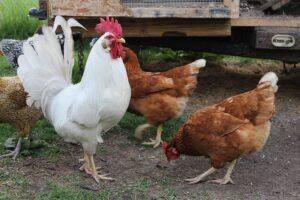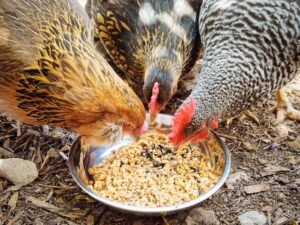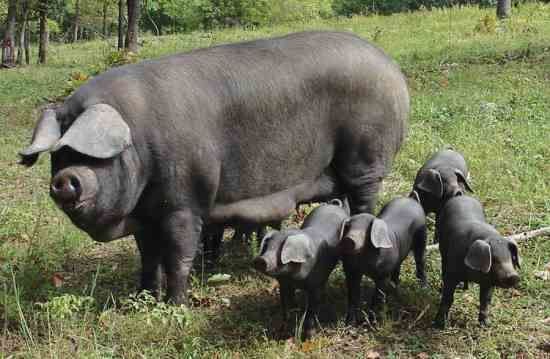Barnevelder Chicken – Characteristics, Origin, Breed Info and Lifespan

In this article, you will learn everything you need to know about the Barnevelder chicken breed.
This is a dual-purpose chicken breed that is great for your backyard poultry farm.
There are many good reasons why you should keep the Barnevelder chicken on your farm.
We will be exploring some of those reasons in this article.
You will learn about this chicken breed, its characteristics, egg-laying capacity, lifespan and so much more.
So, without further ado, let’s get into details.
What is a Barnevelder chicken?
The Barnevelder is a Dutch dual-purpose breed of domestic chicken.
It is named after the town and gemeente of Barneveld, in Gelderland in the central Netherlands.
The Barnevelder hens lay eggs that are dark brown or chocolate brown in colour.
Usually, many add the Barnevelder chicken breed to their flock because of its peculiar chicken eggs.
What is the origin and history of Barnevelder chickens?
There is no straightforward history about this peculiar chicken breed: Barnevelder.
History has it that it was crossbred with Shanghai, the Amerikaanse Nuthoenders and the British Buff Orpington Chicken.
It’s an acclaimed crossbreed with the Shanghai chickens that occurred in 1865 in Barneveld.
But at the end of the 19th century, it was also acclaimed that the Barnevelder’s came about as a result of a crossbreed with the Amerikaanse Nuthoenders.
Also known as the American utility birds.
On the other hand, some say the Barnevelder’s were the product of a cross involving the Orpington chicken breed in 1906.
The only comparison that made sense was the acclaim made by Hans Schippers.
He said that the Barnevelder chickens originated from the Langshan chicken breed.
This was generally accepted because the Barnevelder’s showed striking characteristics with the Langshan.
The name “Barnevelder chicken” was first used in 1911.
At the Landbouwtentoonstelling or agricultural exhibition held in The Hague.
In 1919, the Dutch Poultry Club deliberated on accepting the Barnevelder as a new breed.
Owing to its amazing features, the Barnevelder was exported to the UK in 1921.
This was in response to the need for more chicken eggs.
The Barnevelder chicken at some point had many varieties.
But the double-laced became the principal variety.
Following its prowess, in 1923, a breeders’ association recognised and accepted the breed as a breed of chicken.

What are the characteristics of Barnevelder chickens?
To generalize a breed of many varieties is pretty difficult.
But we have tried to accommodate the general features of each variety.
Below are the attributes that distinguish the Barnevelder chicken;
1. The Barnevelder is a variable chicken breed:
Although most chickens come in 11 varieties and more.
But the Barnevelder chicken comes in more split specifics even in a variety.
For instance, only the hens come in double-laced patterns.
And the males are melanized and black-breasted reds.
Owing to this, there are over 11 varieties of Barnevelder chicken.
However, only a few are recognized.
2. Barnevelder hens have patterned feathers:
The hens of the Barnevelder’s express beautiful patterning on their feathers.
You can sight a brown feather with double black lacing.
Usually, this simple but stunning design produces an ‘arrowhead’ effect. Making it stand out.
But the feathers on the neck are black with no patterns.
3. The Body of a Barnevelder is rectangular:
These birds come with a rectangular body shape.
But their back looks compact and U- shaped.
Their neck is slightly arched,
And their perks at 50⁰.
On the other hand, their feathers are tight and moderately spread.
4. This breed of chicken does not fly:
Unlike the high-flyers Leghorn chickens, the Barnevelder’s are poor flyers.
This is due to the nature of the body structure.
Their wings are high on their body making them not fly well.
5. The Barnevelder’s are single combed birds:
The combs of the Barnevelder chickens are single.
Regardless of the variety.
Each has 5 points.
6. The Body of the Barnevelder chickens are multi-coloured:
Their combs, wattles, and ear lobes are red.
But their eyes are reddish bay in colour.
Their neck on the other hand is black.
The beaks are horn coloured.
Skin and legs are yellow and each foot has four toes.
7. Barnavelder chickens weigh between 5-8lb:
On a general scale, the Barnevelder’s are large birds.
The roosters weigh more than the hens of Barnevelder.
The hens weigh about 5-6lb.
And the roosters weigh around 7-8lb.
8. The Barnevelders have minimal health issues:
Naturally, the Barnevelder chickens can tolerate a variety of climates.
Making them resistant to climate-related illnesses.
Allegedly they are highly prone to Marek’s Disease.
To prevent this, they should be vaccinated at birth.
Also, aside from lice, mites, etc. the Barnevelder’s are pretty much problem-free health-wise.
Table summarizing the Barnevelder breed information
| Skin colour | Yellow |
| Egg colour | Brown or Dark Chocolate Brown |
| Comb type | Single |
| Setter/Broody | No |
| Especially Docile | Yes |
| Use | Dual-purpose breed |
| Cold Hardiness | Hardy in winter |
| Conservation status | On the watch |
| Heat Tolerance | Not especially heat hardy |
| Also Known As | – |
| Personality | Docile, friendly, inquisitive and active |
| Country of origin | The Netherlands |
| Standard | Barnevelder Club of the Netherlands |
| Bears Confinement | Bears confinement well |
| Weight | Male: 3–3.5 kgFemale: 2.5–2.75 kg |
| Varieties | Double-laced, Black, White, Autosexing barred, Dark brown, Partridge, Double-laced, Blue, Blue Silver, Silver-black double-laced |
Why choose Barnevelder chickens?
What’s so special about the Barnevelders?
Would it make much difference to add the Barnevelder chicken to the flock?
To give a perfect answer to the above questions will depend on what you need a chicken for.
But what we do know is that there are some features that the Barnevelder chicken possess that make them one of a kind.
Here’s why you should choose this chicken breed;
1. Barnevelders are the perfect breed for the beginner:
If it’s your first time owning a chicken farm, then this breed will make a good first impression.
Whether you choose to free-range or keep them in a grass run, they will be very easy to care for.
Usually, we regard them as low-maintenance and low-drama birds.
2. Barnevelder chickens are a hardy breed:
This set of birds are healthy and productive even in winter.
Some say they are more productive in winter than summer.
In addition, they can tolerate heat quite well.
3. Barnevelders are predator-savvy:
Their look and active disposition help them avoid predators.
Naturally, they blend in with their surroundings during foraging. This keeps them safe from predators.
They are very alert and can detect predators on time.
And since they can’t fly, they easily take cover.
4. Barnevelders are excellent foragers:
What this insinuates is that your feed bill will be greatly reduced.
They can source their food while destroying your backyard.
Also, you can see them running after frogs and toads.
5. Barnevelders are excellent birds for backyard runs:
Yes, the Barnevelder chickens are perfect birds for your backyard poultry.
And the bigger the space, the happier they’ll be.
Also, the bigger your run, the better.
6. Barnevelder chickens are Non-aggressive Birds:
The Barnevelder chickens are gentle and peaceful.
This attribute makes them live well with a mixed-breed flock.
Although this sounds good, on the flip side, they may be picked up on by more aggressive birds such as the Rhode Island Red Chicken.

What are the disadvantages of having the Barnevelder Chickens?
This breed is outstanding but some things do not sound good about it.
Find out for yourself in this section.
1. Barnevelder hens may start laying eggs late:
This is one of the drawbacks of the Barnevelder chicken breed.
They may take a longer time than necessary to start laying eggs.
Usually, most chickens start laying eggs at 16 weeks.
But the Barnevelder hens can take 8-10 months before laying their first egg.
And that doesn’t sound good!!!
2. Barnevelder chickens are highly susceptible to Marek’s disease:
Although the Barnevelder’s are naturally hardy birds which do not always fall sick, they do have a health challenge.
That’s Marek’s disease.
This illness can be debilitating and ultimately lead to death.
When it strikes, it affects the nerves, spinal cords, and brains of chickens.
This often results in paralysis and tremors.
You can resolve this by vaccinating them at birth.
3. Barnevelder hens aren’t prolific layers
Yeah. Do not count on the Barnevelder chicken breeds to lay many eggs.
On average, they lay at most 200 eggs in a year.
If you want eggs, go for the Australorps or Leghorns.
4. Most Barnevelder hens do not want to be mamas:
This is partially true because some strains can be more broody than others.
But on a large scale, most Barnevelder strains do not want to hatch their eggs.
If you need a strain that can sit on their eggs, then go for the American strains.
5. Because they are good foragers, they may destroy your lawn:
Each and every day they will tear up the lawn.
And they will do that so well that you will not recognize your beautiful luscious lawn again.
6. The Barnevelder chicken combs are prone to frostbite:
Although they can survive the bitter cold, they are still, unfortunately, prone to frostbitten combs.
I guess that’s a curse from Ursula on all single-combed breeds.
To solve this issue, you can either smear their comb with Vaseline.
Or you can get the Sweeter Heater.
Frequently Asked Questions About Barnevelder chickens
1. What is the lifespan of Barnevelder chickens?
Just like most chickens, the Barnevelder chicken breed lives up to 10 years.
But this depends on how well taken care of they are.
2. Are Barnevelder chickens good for meat?
Yes, they are good for meat.
But they may not produce a large chunks as you would like.
At 6 months of age, they can be table-ready.
However, many homesteaders have said that the Barnevelder chickens really don’t make the best table birds.
3. Can Barnevelder chickens be trained as pets?
The Barnevelder chickens are easygoing and amiable birds.
You know the kind that will greet you with low-key chattiness when you come home.
Or come into the garden.
Their exceptional docile nature makes them great pets.
The kind of pets that are kid-friendly, gentle and delightful.
This makes them suitable for the family.
The roosters and hen can be tamed as pets.
But it’s advisable to tame them as pets earlier.
4. Are Barnevelder chickens good egg layers?
Well, we can say they are good on average.
Although they do not compete with the Cochin or Australorps, they can produce quite a handful of eggs.
Usually, they lay about 3 to 4 dark large brown eggs in a week.
5. How often do Barnevelder chickens lay eggs?
As earlier stated, the Barnevelder’s lay about 3 to 4 eggs per week.
On average, they lay about 175–200 dark brown eggs per year.
Each egg weighs about 60–65 g.
And unlike most chickens, they lay through winter.
Making them more consistent egg-laying birds than most chicken breeds.
6. What do Barnevelder chickens eat to grow big?
A feed of high protein content will be enough to have the Barnevelder’s grow big.
However, this should be compensated with foraged diet.
Such includes, mealworms, grubs, veggies etc
Kindly note that the Barnevelder chicken will not grow bigger than normal.
7. How fast do Barnevelder chickens grow?
The Barnevelder’s do not grow fast.
As earlier stated they take time before laying eggs.
This is in relation to its delayed growth.
And this is totally natural.
8. Are Barnevelder chickens noisy?
Not quite.
The Barnevelder’s tall a lot but usually in a low and quiet voice.
Unlike Rhode Island Reds who like to shout, the Barnevelder chicken will keep the neighbours at peace with you.
9. What is the habitat and environment of Barnevelder chickens?
A large coop will give the birds enough space to forage.
Since they do not enjoy hot and humid weather, they will need to have shade and water available.
Conclusion
Barnevelders are a standout breed due to their unique feathers, quirky personality and of course those pretty and peculiar eggs that they lay!
Adding this to your flock will bring make a great change.
But ensure you have the necessities to handle its extravagance.
References:
- 12 Best Chicken breeds for Eggs – chicken breeds for eggs
- When Do Chickens Start Laying Eggs Regularly?
- How Many Eggs Does A Chicken Lay In A Week?
- Fermenting chicken feed – The definitive guide
- 10 Sure Ways To Stop Chickens from Eating Their Eggs [+Bonus]
- 6 Best Chicken Egg Incubators for Chicken Eggs and Other Birds











